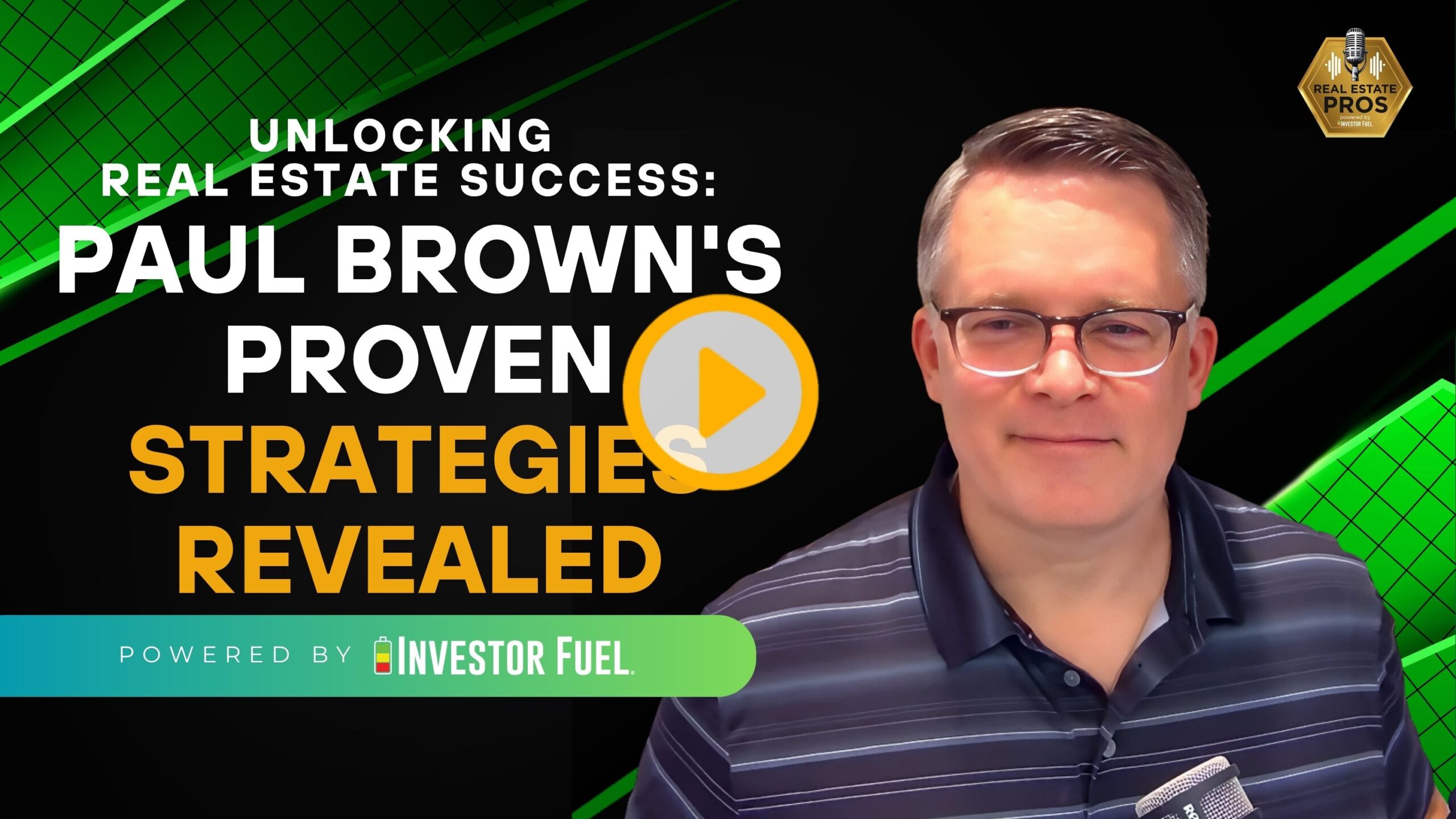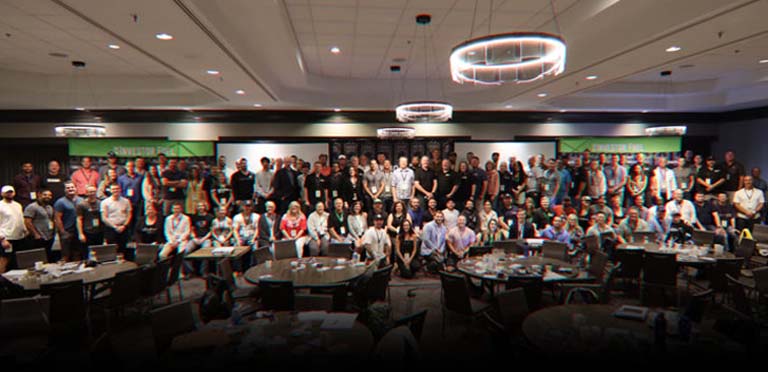
Show Summary
In this conversation, John Harcar interviews Paul Brown, who shares his journey from engineering to finance and ultimately to real estate investing. Paul discusses his experiences in private lending, creative financing methods, and how to acquire properties with little to no money down. He emphasizes the importance of transparency in transactions and the benefits of seller financing. The discussion also covers the various lending practices and strategies that can help real estate investors succeed.
Resources and Links from this show:
Listen to the Audio Version of this Episode
Investor Fuel Show Transcript:
John Harcar (00:01.184)
Okay, hey guys, welcome back to our show. I’m your host, John Harcar, and I’m here today with Paul Brown. And what we’re going to talk about with Paul, you know, besides his journey in business and finance and real estate, we’re going to talk about, you know, how some methods to acquire property with zero money down. Obviously we’ve all heard the zero money down play before, but Paul’s going to share with us some, some, some techniques that he, he advises on. Remember guys here at Investor Fuel, we help real estate investors, service providers,
I mean, all real estate entrepreneurs, two to five X their business. And we do that because we have the tools, the resources, and the community to scale your business and create a life that you’ve always wanted to have. So Paul, welcome to our show.
Paul Brown (00:47.626)
Thank you very much. It’s great to be here, John. Appreciate it.
John Harcar (00:49.496)
Yeah, Yeah, I appreciate you coming on here. I look forward to talk any further about some of this stuff. Why don’t you start off by kind of giving our audience a little background on you, you know, kind of what got you into the business, you know, your journey and, know, what brought you to today?
Paul Brown (01:03.87)
Yeah, thank you. So I grew up as an engineer, converted into finance and banking, but I had a mom the whole time that was involved in real estate. And so, you know, as a little kid, I got dragged around cleaning rentals and all that fun stuff that you get to do when you’re 12 years old and you’re…
John Harcar (01:12.622)
Okay.
Paul Brown (01:22.962)
your mother drags you around. Anyway, I learned an amazing amount from her that I didn’t realize until later in life how creative she was with the real estate, the kind of stuff she was doing. Along my career as I was going through the traditional W-2 career in engineering and then finance and eventually into international business, I spent about 15 years in Asia. I was always buying little properties on the side, more of a retirement play. And a number years ago, I decided, hey,
John Harcar (01:29.217)
Yep.
Paul Brown (01:52.481)
kind of want to leave this gig. was a really good gig, but my kids were at an age that it made sense. And we decided to leave that and come back home to Utah where I grew up. And so we came back home to Utah, and that’s when I started accidentally a lending business. I came home to get into real estate investing and start buying multifamily. And somebody called me one day and asked if I’d lend money to a fix-and-flipper in second position. And I was just dumb enough to do it.
John Harcar (02:18.307)
Uh-huh.
Paul Brown (02:21.984)
I lent $89,000 into this deal with this fix and flipper at a rate that I thought was absurd, but much lower than what his other offers were and did it poorly as can be. I look back and look at the contracts I was using and think what in the world was I doing? But that accidental lending experience,
John Harcar (02:27.736)
Mm-hmm.
Paul Brown (02:47.076)
really triggered something in me. I really had fun with it and it just took off and I started lending to a bunch of other people. Obviously spent a little more time with legal, spent a little bit more time with some mentors, really improved the business and started growing that private lending business. And that’s targeted really towards wholesalers, fix and flippers, those kinds of people, really small.
John Harcar (03:06.734)
Mmm.
Paul Brown (03:15.454)
ground up builders, things like that. But then I ran out of money relatively quick because that’s my law in life, right? Elon was not funding me. And so I didn’t have that bankroll. And I thought, all right, I need more money. And I’d had some money come in from different people just saying, hey, can I give you money? Can I be part of what you’re doing? And I decided, yeah, I need to do this a lot more legitimate and legal.
John Harcar (03:27.074)
Great.
John Harcar (03:44.408)
Mm-hmm.
Paul Brown (03:44.897)
And so I went out and I started a credit fund, a debt fund. And that really then changed the game, right? Having essentially a vehicle that allowed me to bring people along with me and share the returns. But because they were coming along with me, they allowed it to open doors and do more lending. So it’s been a really fun.
John Harcar (04:01.027)
Mm-hmm.
Paul Brown (04:11.52)
growing process and we have miles and miles to go. We’re just still in our infancy, but it’s been a blast and I love both sides and we’re slowly building a team of the right people. It’s me and a partner of mine that are really the most actively engaged and then three, four people on our staff.
John Harcar (04:24.63)
Awesome.
John Harcar (04:33.208)
So if you’ve watched my podcast, I like to go back. Like what type of stuff was your mom doing in real estate? Was she an agent? What was she doing?
Paul Brown (04:40.978)
So she was initially an agent, but she was doing a lot. I think she did that for cash flow. But then she was always trying to find properties, know, something being foreclosed, sold on the county steps. Always, she was really, I wish I had this skill that she has. She was very good at connecting with people. So she had built a really great network of people that would call her and say,
Hey, do you want to buy this property over here? It’s not on the market yet. Right. And finding some creative ways of buying these things, turning them into rentals, holding them a little bit. That sitting in a car with her, though, my education, and I remember moments, specific moments, you know, in a car at a certain place, talking to her as a dumb little kid, you know, but she would talk to me like an adult.
And so we talked about what she was doing. I understood, I’m sure, like 3 % what she was saying to me. But a lot of those things sunk in and I just kind of grew a love for real estate, more real estate investing. Not so much realtor, no slight on realtors, but that wasn’t the thing that hit my heart. It was more the investing, the property, the asset, right? The way the asset plays out through the future. I really appreciate her.
John Harcar (05:41.738)
Right.
John Harcar (05:50.594)
Mmm.
Paul Brown (06:06.74)
doing that with a boneheaded little kid is awesome.
John Harcar (06:09.73)
Were you, do you think, and you said you went into, did you say engineering, right? Do you think back then you were maybe more, and you still might be an introvert? And maybe that was kind of what pushed you to not go into real estate, because you saw all that interaction that had to be done?
Paul Brown (06:27.351)
Maybe, I grew up in a really traditional mindset of get good grades, go to school, get a good job. I had a AP chemistry teacher in high school that said, look, if you want to become a doctor or whatever these things are, go get an engineering degree first. Because if you don’t like being a doctor or don’t like being whatever, you can actually get paid.
with a real job. Don’t get a biology degree, or the only job left is teaching biology in junior high. Again, no slide on that. My dad was a biology teacher in junior high and he’s awesome. I worked in engineering for about five and a half minutes. My engineering career was really short. We did robotics in school. I build a lot of stuff in that vein. It was intellectually really fun and curious.
John Harcar (06:54.542)
Or psychology.
Paul Brown (07:14.75)
but I immediately moved from engineering into more of product management and project management type stuff, and then from that into banking. To your question though, I found over time, I thought I was an introvert all my life because I don’t like a huge crowd of people. I love a small crowd of people. I love people, but I don’t like 500 people in the same room. I don’t know why, just never liked it. But what I found is,
I don’t have the natural tendency of a real true introvert of wanting to communicate in a long-form email. Right? I’ll get up and walk out of my office and walk into their office and start talking to them, which to an introvert is torture if somebody just walks in and starts, like, dumping stuff on you, right? So I think I play both sides of that. I’m a little bit of an introvert and…
John Harcar (07:58.956)
Talk into him instead, yeah.
John Harcar (08:04.918)
Yeah, right, right.
Paul Brown (08:10.952)
at the same time really love people and love that personal engagement.
John Harcar (08:14.99)
As far as your business now, what does it look like? I know when we talked prior, you obviously do a private lending, you have this fund. Tell our audience a little bit more about what all that looks like.
Paul Brown (08:28.842)
So we, the lending business is focused on a few different types of loans, all non-traditional, I’d say. So rather than what people would call hard money, the first position loans that a flipper’s gonna go get, or long-term funding for buy-in holds or any of that kind of thing, we focus on very short-term lending. When it comes to a wholesaler,
That’s maybe the most simple, so I’ll talk about them and then flippers. A wholesaler, sometimes they’ll call us for earnest money. We’ll do earnest money during the month.
they’ll usually be calling us for that or double closing, right? They negotiated such great numbers, they kinda wanna close it twice and not necessarily show anybody how great they did. Or they’re selling it to a fund and the fund will only buy it on a purchase and sale agreement, not on an assignment. So they need to double close it. And we’ll facilitate that first leg, the front leg purchase so that they can double close. The flipper side,
We’re usually, initially we were usually doing second position notes. Incredibly high risk. Like, it’s hard to fully in words explain how high the risk is. But that we lose full capital on transactions on a relatively meaningful ratio maybe conveys that.
but we’re helping them make a transaction happen that otherwise would never happen, right? Otherwise, they’re just not able to get in the deal and do that flip. Both of them, we do another type of transaction we might talk about a little bit later.
Paul Brown (10:14.302)
People that are familiar with Pace Morby would call it a Morby method. Some people familiar with another online teacher would call it Stack. There’s a couple other method names. 30 years ago, it was called the 70-30. And it’s a transaction where we’re facilitating some down payment money really quickly in and out that allows either a flipper to buy that property without a second position lender by using some seller carry back.
John Harcar (10:43.63)
Okay.
Paul Brown (10:44.026)
or allows a wholesaler to go buy the property that only has a partial seller carry back and hold it as a rental. A lot of wholesalers are looking to build a portfolio, but don’t have a lot of cash on hand. So it allows them to do it with very little or no money down and start building that rental portfolio. Those are the kind of transactions we do. We’re focused more on that last one lately, but we do all of them. We love doing them all.
John Harcar (11:03.799)
Okay.
Paul Brown (11:12.882)
and we’re just not that traditional, right? We get a lot of phone calls. We do my first position on whatever and we’re just not in that space.
John Harcar (11:15.203)
Yeah.
John Harcar (11:20.718)
Okay, so it sounds like you’re doing some Gator lending for like the EMDs and stuff, something similar to that, right? Yeah. Yeah. Yeah. That’s why it’s just, it’s okay. So let’s say, and that’s a good time to segue in to talk about that acquiring with zero money down and how you mentioned some people call it like the pace Morby method. Explain how, explain the process, explain the method to our audience who maybe don’t really understand what the whole thing is.
Paul Brown (11:25.744)
Yeah, yeah, yeah, that’s a name for it recently.
Paul Brown (11:46.389)
Yeah, so the intent of this is to be able to purchase a property with little to no money. The vehicle, the most critical component of this tends to be the willingness of a seller to seller carry a portion in a second position lean. So.
If you can get a seller to do that and we require a bit of a disclosure, we want to make sure the seller really knows what they’re doing because this transaction, if done without disclosures and transparency, can be something that…
we stand on the exact opposite side of. We don’t believe in, right? We believe this is fantastic transaction when done openly with disclosures and in front of everybody’s face, but can be something that could put a seller in a horrible position if done wrong. And so what this transaction is, is in a step-by-step method, is let’s take the wholesaler scenario where wholesaler is trying to buy a property to hold for rent. They’re trying to build their portfolio.
John Harcar (12:33.068)
right.
Paul Brown (12:59.75)
The wholesaler, oftentimes, a lot of wholesalers I know will have the case where they can’t get a cash offer accepted. So then they go with a creative offer and they try to get it seller financed. And the seller says, sure, I’ll do seller financing with you. But they won’t do 100 % or 90%. They say, I’ll do seller financing, but I want 50 % upfront. Right? And at that point, usually most wholesalers say, okay, this is a bad deal.
John Harcar (13:21.774)
50 %
Who’s got 50 % hanging around?
Paul Brown (13:29.33)
Right? They want 50 % upfront. Like I don’t have that in the pockets of my winter coat, right? And so what we do is we say, Hey, don’t throw that deal out. What you can do is talk to that seller and ask them if they’re willing to do that in second position and make sure they’ll do it for an extended amount of time. You can’t be dealing with a balloon payment in three years. So make sure you’re out seven or 10 or better.
and they’re willing to do it in second position. Maybe you even negotiate backwards and say, look, I’ll give you 60 or 70 % down if you’ll do that for me. Because you need at least about 30 % seller carry to make this happen. And then what we do is we partner with a DSCR lender that comes in and is willing to fund a portion, 75, 80 % of the purchase, right? Based on its rent, its ability to cover debt.
Well, they won’t let a seller carry be the down payment, because that’s just not how it works. So we will partner with the buyer and we’ll put the down payment money on the table to close that first transaction. And then the seller carry in the second transaction comes in in a second position note and funds us out, right? So we get.
John Harcar (14:44.75)
50%.
Paul Brown (14:56.176)
exit out of the deal. And what the whole seller now has is a DSCR loan for part and a seller carry for part. Now we have some rules about when we’ll play this game. Like I said, disclosure across the board is one of them. The other is it needs to really actually cover the debt servicing. Right? If it doesn’t, the seller is the one holding the most risk in the deal. They’re in second position.
John Harcar (15:23.402)
Right, because they’re second position, they’re second to get paid. Yeah.
Paul Brown (15:26.196)
Yeah. And so since we lend in second position, we have a part of our heart that leans towards the risk a second position lender takes. So we want to make sure that they’re not putting them in immediate harm in that first few years because it doesn’t even cashflow. Another thing is we want to make sure that the DSCR lender doesn’t have explicit
what explicit rules against a second position ever being placed. Some do. And if they say, hey, at any point of a second position is placed, we can call this due. Well, that’s just a bad scenario because you make a mess six months, 12 months, 18 months down the line. And we’re not in the business of making messes. We’re trying to facilitate positive things happening. And the last one is how much it’s leveraged.
John Harcar (15:58.978)
do, yeah.
John Harcar (16:14.264)
Solutions.
Paul Brown (16:19.328)
So it tends to get leveraged slightly because closing costs, if you really go in at zero down, if the seller carries 25 % and the DSCR is 75%, somebody has to show up with closing costs. And our tiny fee, our fee is actually really minuscule in this compared to a second position loan. So usually what happens is they’re coming in with 28 seller carry or 30 seller carry with the 75. So they’re 105 % leveraged.
John Harcar (16:32.61)
Right?
Paul Brown (16:48.99)
And we’re really sensitive to that because it’s the seller that’s being leveraged, right? And sometimes we’ll have buyers that say, well, we want to pay ourselves. We want to take money out. And the seller’s willing to do 40%. We’ll do their 40 and the 75. Right? But that leverage, every dollar they take out, we view it, and I know this sounds really nitpicky and everything, but every dollar they take out is
John Harcar (16:52.664)
That’s being leveraged,
Paul Brown (17:19.026)
An inch they bury a seller, right? And so we want them to look at it as, hey, I’m so fortunate I can buy a property with no money down or only closing costs down rather than, hey, how much can I suck out of this at somebody else’s expense? And so we get buyers that are willing to, they like that game. That’s where their standards are. They want to do it that way. And we love doing this business with them.
John Harcar (17:21.506)
Yeah. Yeah.
Paul Brown (17:49.057)
Sometimes we get buyers that just want to get every, and that’s their way and their standards. just, we don’t feel good about those transactions, so we don’t necessarily participate. And then, sorry to get so wordy, but the example for the flipper is almost the same, but it’s so much easier to see how a flipper benefits in dollars. So if you took a flipper that said they need a hundred, it’s a $400,000 property,
John Harcar (17:59.04)
Yeah.
Paul Brown (18:18.624)
They’re going to get 300 from a hard money lender and their renovation costs. And they’re coming to me for a hundred thousand dollars of second position. That a hundred thousand dollars of second position for six months is really expensive. And it’s just how it is, right? They’re probably spending 30,000 bucks to get that. Well, if they do this type of transaction instead where they’re able to get the seller to carry for 12 months.
John Harcar (18:34.242)
Hmm. Yeah, sure.
Paul Brown (18:48.736)
Right? They don’t need 10 years now. They’re flipping it. If they can get them to carry 30 % for 12 months, they don’t need a second from me. But we’ll facilitate this with the hard money lender. We’ll put the money in, make it close the exact same steps. Now they’re spending $2,500 on me instead of $30,000 and they just made $27,000 more, which the way I look at it,
John Harcar (18:49.09)
Yeah. No, they’re flipping it, yeah.
John Harcar (19:15.672)
Yeah.
Paul Brown (19:18.56)
from a history of risk management and whatnot is they just de-risk their flip. They just created $27,000 more cushion in a flip, which means the first position has less risk. The seller even has less risk. Everybody just took less risk by them creating a cushion through this transaction. That’s one of the reasons we like it. I don’t know if that makes a lot of sense, John, but yeah.
John Harcar (19:41.954)
Yeah. No, it makes a ton of sense. really, really, really does. And I love that model. Are you only lending? Where are you lending anyways?
Paul Brown (19:51.177)
We will do that transaction everywhere. We’ll do EMD double close across the country. Second position, we only land in maybe two thirds of the states. avoid some of the, like Nevada requires you to have a license with a W-2 employee located in the state. Well, we don’t employ staff in, you know, so we have limitations with some states, but otherwise we’re happy to lend. Yeah.
John Harcar (20:12.321)
Right.
Mm-hmm. Are you landing in Boise?
Paul Brown (20:21.216)
Yeah, we do some stuff in Idaho, but I know it’s a little tricky because Idaho does have some lending laws that yeah. Yeah. Yeah.
John Harcar (20:25.698)
They do. Well, we’ll talk offline. I love everything you shared. It sounds fantastic. And I think it is a way for wholesalers,
If there’s folks out here that are listening that, you know, what she said resonated with them, they want to reach out to you and connect and talk more. How do they get in touch?
Paul Brown (20:47.194)
great question. Our website is realquickfunds.com, R-E-A-L-Q-U-I-C-K-F-U-N-D-S.com. At the bottom of that, you can either schedule a meeting, the email address is there, all the contact information’s right there. It’s the website’s easiest way. You can also submit deals straight through to us right off the website.
John Harcar (21:02.67)
Mm-hmm. Okay.
John Harcar (21:08.388)
nice. Perfect. And we’ll put all that stuff in the show notes. Paul, I really appreciate you coming by again and sharing all this stuff, A lot of great information. Folks at home, I hope you took good notes. And hope you enjoyed this as much as I did. And we will see you all on the next one, Paul. Thank you again. Cheers.
Paul Brown (21:12.17)
Thank you.
Paul Brown (21:27.947)
Thank you.






